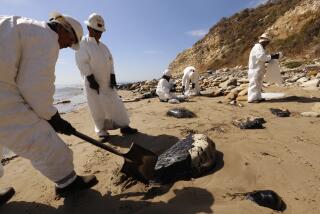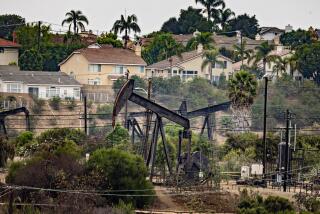Bradley Approval of Oil Drilling
- Share via
When I first saw Mayor Tom Bradley’s article (Editorial Pages, Jan. 25), listing his reasons for signing the ordinances allowing oil drilling in Pacific Palisades, I expected at least some rationale for his bewildering flip-flop on the Occidental Petroleum issue.
But alas, after reading the mayor’s explanation, which was replete with inaccurate, inconsistent and irrelevant observations, I was more mystified than ever.
Tom Bradley has yet to give a cogent, acceptable justification for his most shocking about-face in recent memory. In fact, each of his defenses is a fallacy.
First, the mayor justified drilling in Pacific Palisades on the grounds that it already exists in Venice. But the Venice wells also existed in 1978, when the mayor vetoed Occidental’s earlier attempt to drill in Pacific Palisades.
We must also remember that the Venice wells were drilled in an earlier era, before the advent of today’s stringent environmental-review requirements, and before the 1972 passage of the California Coastal Act, which meant even more detailed environmental reviews for coastal projects.
What was done many years ago in Venice does not justify drilling elsewhere on the coastline today. In any case, if there is an equity issue, why shouldn’t the mayor have seen it in 1978?
Next, the mayor says there were “several things that set this application apart from the last, which I vetoed in 1978.” Really? Not according to a letter from the mayor to a citizen, dated March 31, 1982, in which he said, concerning the latest drilling proposal: “. . . the request appears to be identical in design and operational characteristics to the proposal which I vetoed in June, 1978. I do not know of any circumstances which would change my view on this matter.”
The Occidental proposal underwent no changes between the 1982 letter and 1985. Only the mayor’s opinion of it shifted.
Third, there is the de-watering system, alleged to diminish the risk of landslide on the notoriously unpredictable Pacific Palisades bluffs above the drill site by draining some water from within the hillsides.
It would be wonderful to think these devices would assuredly prevent future landslides, but this is impossible.
Hanging one’s case on draining some water overlooks two facts: first, to the extent that it is a public benefit, it could be provided without oil drilling (indeed, property owners in Pacific Palisades offered to pay for a de-watering system through private contributions, which would mean a public improvement without public cost--and without oil drilling). Second, Occidental’s offer to pay for the system should be irrelevant. After all, developers are always offering this or that if the city will approve their projects. The decision has to be based on whether the project itself is sound, and not on some collateral offering.
Though a de-watering system is required to proceed, it does not change the essential character of the project. The bluffs have slid and they will slide again, with or without dewatering.
Next is the issue of whether oil drilling violates the spirit and letter of the community’s master plan. It was the mayor himself who declared, in his 1978 veto message, that the project would be in conflict with the community plan for Pacific Palisades. And, as the mayor himself stated in his March 31, 1982 letter, the current project and its 1978 forerunner are the same. The community plan is the same, too. Why isn’t his opinion the same?
MARVIN BRAUDE
Councilman, 11th District
Los Angeles
The harangue over oil drilling in the Palisades by the vocal minority opposed to it is as pointless as the dead horse they keep publicly beating. If we will take a minute to sit back and think, close our ears to the boisterous shouting and our eyes to the melodramatic signs on posts and walls along the beach, we will realize that the arguments for and against Occidental’s proposal have all been satisfactorily resolved.
The project is environmentally sound, structurally safe and aesthetically attractive. There will be no disruptive landslides, odors, noises, pollutants or traffic. No one will suffer adversely because of property devaluation, nor will anyone become rich on the mineral rights. The City of Los Angeles will be given an additional source of income for several years to implement and improve community services and programs.
Even more depressing than the broken-record arguments of No-Oil Inc. and their supporting legislators is the irrelevant correlation of this project with offshore drilling. The proposed Palisades-based well, as the present Venice well, will in no way lead automatically to drilling in Santa Monica Bay. The well will tap the oil resources inland--away from the beach--and for practical, realistic purposes will be the same as an oil well in the Mojave Desert.
Mayor Bradley did only what any intelligent, informed and concerned civic leader would do; he evaluated the present proposal, he listened to the recommendation of the majority of the City Council, he consulted the environmental experts and acted accordingly for the benefit of the community. All the rest is talk.
CHARLES H. WACKER JR.
Santa Monica
We have supported Tom Bradley for mayor enthusiastically and wholeheartedly in every election since his first campaign for mayor in 1969. He has been a fine mayor.
However, his decision to allow oil drilling in the Palisades is wrong. His article in The Times underscores the weakness of his position.
Drilling for oil, wherever appropriate, is essential. Our national security requires that we reduce our reliance on foreign sources of energy. In this instance, no compelling reasons exist to justify Occidental’s request to drill for oil in the Palisades. In fact, there are many reasons why Occidental should not be allowed to drill.
In his article, Bradley says, “If we can allow oil drilling (in Venice) how can I treat the Palisades any differently?”
Because oil drilling is allowed in Venice does not justify the same policy in the Palisades. Does the mayor believe that if a toxic waste dump was situated in Encino fairness would demand siting one in Bel-Air also?
Bradley claims that Occidental’s oil drilling “will make the bluff more stable than if no drilling were permitted.” Yet in testimony before a City Council committee, Joseph Cobarrobias, chief geologist for the Department of Building and Safety, said that slope stability could not be guaranteed above the proposed drilling site even after the installation of a drainage system. He went on to say, “If you wanted to build a hotel down there, we wouldn’t approve it.” Another geologist who testified at the same hearing said that Occidental’s proposal “provides no assurance of safety.”
Should a landslide happen, the likelihood exists that the Pacific Coast Highway would be blocked. This would create a serious hardship for the residents of the area, commuters who use the Pacific Coast Highway to get to and from work, and the millions of people who use the beaches.
Worse, a landslide could lead to an oil spill in the Santa Monica Bay. This would pose a grave danger to the most heavily used recreational beaches in the country, endanger irreplaceable natural habitats, and threaten the economy of the region--which is heavily reliant on tourists and beach-goers.
We were also surprised by he mayor’s reliance on the Interior Department for assurances that his decision would not weaken chances for extending the existing offshore oil drilling moratorium. This is the same Interior Department which has fought so hard to defeat the moratorium and open the Santa Monica Bay to oil drilling.
We hope that he is right, but there is no credible evidence to support the mayor’s views. Members of Congress have already asked how those of us from Los Angeles can expect to protect the Bay in light of the City’s actions. (Last year, Congress agreed to extend the moratorium by a vote of 21-20; one vote change would have defeated the moratorium.)
The California Public Resource Code allows the state to drill in a protected oil and gas sanctuary if adjacent onshore drilling depletes the offshore oil resources. This is exactly what is threatened in this case. Once the state oil and gas sanctuary is invaded, opponents of oil drilling in the Santa Monica Bay can no longer argue that we are seeking federal protection for protected state sanctuaries.
MEL LEVINE
Member of Congress
27th District
Santa Monica
GARY HART
State Senator
18th District
Santa Barbara
More to Read
Sign up for Essential California
The most important California stories and recommendations in your inbox every morning.
You may occasionally receive promotional content from the Los Angeles Times.










